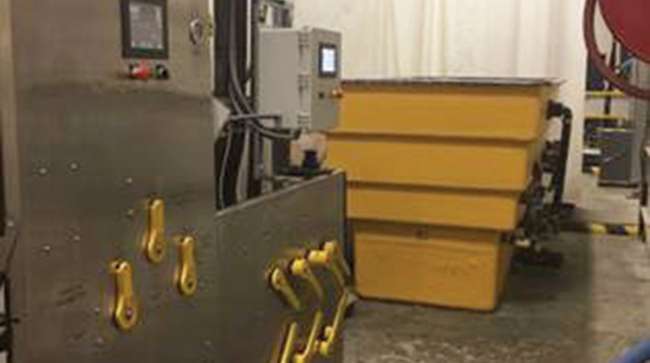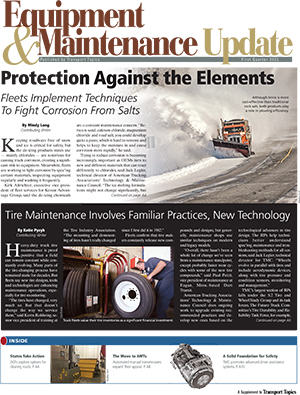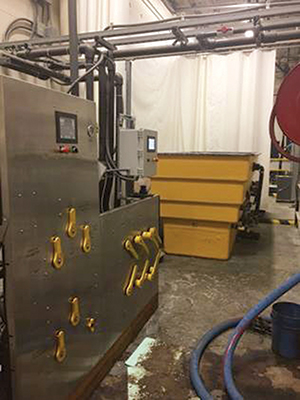State DOTs Find Alternative Solutions to Clearing Roads

[Stay on top of transportation news: Get TTNews in your inbox.]
When winter snow imposes its will on the roads, it’s typically mitigated by various amounts of sand, calcium chloride, magnesium chloride and road salt, but these de-icing agents also are a major contributor to corrosion problems for fleets. However, states are working to alleviate that problem by decreasing the amount of product needed to clear the roads, implementing brine technology and adding corrosion inhibitors.
“Corrosion from road de-icers is a multibillion-dollar issue for fleets … once it starts, it starts eating everything alive,” said Brian Herrington, area sales manager for Atro Engineering Systems.
Phill Sexton, CEO of WIT Advisers, a cooperative of landscape and winter management companies throughout North America, said that over the years, the amount of salt used to clear roads has increased as states have developed bare-road policies and drivers increasingly expect clear dry pavement. As more salt is used, Sexton noted, it creates issues for the environment as well as equipment.

- Fleets implement techniques to fight corrosion from salts
- State DOTs find alternative solutions to clearing roads
- Tire maintenance involves familiar practices, new technology
- Automated manual transmissions become industry's popular option
- Braswell: Keeping a solid ADAS foundation
- Freeze: Trucking is the line between other industries
“We’re finding out salt is a pollutant in a major way to fresh-water resources,” he said, adding that chlorides can’t be diluted, and they don’t biodegrade. “It is killing off aquatic ecosystems and becoming a drinking water hazard.”
Dan Schacher, Fairbanks maintenance district superintendent for the Alaska Department of Transportation and Public Facilities, said deciding whether to put down a chemical in the winter is the decision he anguishes over the most.
“It impacts people. It impacts my budget, but there is a societal cost to a crash, and there is a really big societal cost to a fatality,” he said. “If I can show we’re reducing accidents and fatalities, then I am comfortable making that decision. If you wash your equipment or use these salt-away products we use on our equipment, it will be fine.”
Thomas Peters, maintenance research and training engineer for the Minnesota Department of Transportation, said MnDOT has increased the use of RoadWeather Technology, which primarily consists of mobile data decision support and automated vehicle-location equipment, so it can apply and monitor the appropriate amount of material based on current weather conditions.
Some states are working to reduce how much salt they use. In the past few years, DOTs have been good at calibrating equipment, said Laura Fay, a research scientist and program manager for cold climate operations and systems and infrastructure longevity and sustainability at Montana State University’s Western Transportation Institute.
“A big part of this has been motivated by reduced and shrinking budgets over time,” she said. “They can’t just keep buying salt because they can’t afford it, or it is heavy winter and they cannot get more salt in time.”
Fay noted the most commonly used de-icer is sodium chloride. “In liquid, it is called brine, as a solid, it is called rock salt. The reason it is used the most is it is cost-effective, and it is the cheapest,” she said. “With the newest advances, we’re able to add corrosion inhibitors to it. We can blend it so it can work in colder temperatures.”
Brine technology plays a significant role in reducing the amount of product needed to clear roads, WIT Advisers’ Sexton said. He added that rock salt used for de-icing doesn’t take effect until it converts to a brine anyway. Salt brine is a 23.3% salt solution compared with a grain of salt that is 100% salt, Fay said. With liquids, it takes 40 gallons per lane mile compared with 250 pounds of rock salt per lane mile to clear a lane, she explained.
Liquid applied ahead of the storm, called an anti-icer, can be put down well ahead of time, Fay said. “If they know a big storm is coming in, they can go out 12 hours in advance. They can treat the roads when they’re on shift and not on overtime,” she said.
The liquid can dry, and as snow and ice start to form on the road, the brine activates and prevents snow and ice from bonding to the pavement. “When you go and plow, it makes plowing much easier,” she said, adding that studies show anti-icing ahead of a storm has other benefits, such as getting to a cleaner pavement faster.
One of the benefits of brine is that it can be applied where needed without losing material. A study by Michigan DOT showed that one-third to one-fourth of the rock salt put down by a snowplow immediately bounces and scatters off the roadway, Fay said. “When they started pre-wetting, they found hardly any material was lost,” she explained.
Sexton said he has seen the amount of salt needed to be reduced by 70% or more when switching to a brine. “Why wouldn’t you do that? There are economic and environmental benefits to doing this,” he said.
Sexton explained that the most significant barrier to brine use is the infrastructure investment that is required.
“We work with the New York Department of Transportation. One of their challenges is they have a huge fleet, and it requires a number of years to convert or supplement that fleet,” he said, adding that the use of brines is in its early adopter phase, which is causing some cost issues. “I think it will be solved as this becomes more mainstream.”
However, the long-term cost savings can justify the initial investment in new equipment needed to switch to liquids from solids. “You’re putting much less product onto the road and into the environment,” Western Transportation Institute’s Fay said.

Brine technology plays a significant role in reducing the amount of product needed to clear roads. (Alaska DOT)
The Ohio Department of Transportation has various tools in its arsenal to clear roads, ODOT spokesman Matt Bruning said. The most common is rock salt, but the state is increasingly using brine made at its garages by mixing rock salt with tap water.
“We’ve found the brine makes a big difference when used as an anti-icing treatment to the roadways before a storm, bridge decks and ramps when it’s frosty, ” he explained, “and even during and after a storm for snow removal.”
Bruning said brine costs pennies per gallon to make, so it’s more cost-effective than straight rock salt, but he said both products play a role. “Brine has the advantage of being cheaper and ensures the material sticks directly to the road surface. Salt offers a little traction and extends the ice melting process by taking more time to go into solution,” he said.
ODOT also uses an agricultural byproduct called Beet Heet, a beet molasses, when the temperatures get below 20 degrees. Beet Heet contains anti-corrosion materials.
“The materials are on the Clear Roads qualified products list,” Bruning said. “The products must be 70% less corrosive than rock salt brine to qualify to be on the list.”
Nearly anything with a carbohydrate-rich sugar, such as apple pumice that is left over from making apple cider or brine left from making mozzarella cheese, can work as an additive.
Fay noted that there are more products being discovered all the time. The goal is to partner with a group that already had a waste stream that is usable. Even if the brine isn’t applied directly, it can be used to coat rock salt.
“That then sticks to the road better, so you don’t lose as much to the environment,” she said. “You also get a corrosion inhibitor.”
Corrosion inhibitor use is widespread, Fay continued, adding that most states use some product that has a corrosion inhibitor in it. “It could be as simple as the byproduct from beet sugar processing to as complex as a chemical derivative,” she explained. “There is a huge spectrum of options and costs.”
In Alaska, Schacher can make brine for 18 cents a gallon, but the cost per gallon can increase to $2 to $2.50 a gallon when a corrosion inhibitor is added. Schacher said he uses a product from Envirotech Services Inc., which also is on the Clear Roads list, but shipping it to Alaska is costly. Despite the expense, having that choice still provides value.
“People want to drive the speed limit even in the middle of winter,” he said, “so this is another tool in our toolbox we can use.”
Want more news? Listen to today's daily briefing:
Subscribe: Apple Podcasts | Spotify | Amazon Alexa | Google Assistant | More

